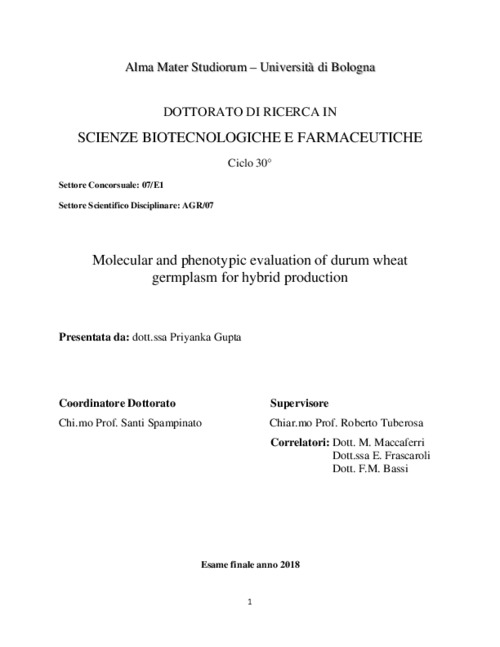Molecular and phenotypic evaluation of durum wheat germplasm for hybrid production
Abstract
Global food security is faced with serious challenges including population growth and changing
climate. To cope with these challenges a paradigm shift is required to ensure sufficient and
sustainable crop production. Hybrid technology is one of the strategic solutions for crops
including durum wheat. To translate hybrid technology in durum wheat, an understanding of
heterotic behavior is required. The present study aims at generating the basic knowledge of
hybrid technology and examines the magnitude of heterosis for yield and yield components
through evaluation of eight parents along with 28 F1 hybrids (half diallel) from University of
Bologna and 25 F1 and 10 parents (NC II design) from ICARDA, Morocco. The hybrids along with
their parents were evaluated in the field-experiment carried out in Bologna, precision
phenotyping platform (Lemnatec) at different levels of water stress in Metaponto and in nearfield
condition
via
a
basket
method
in
Rabat
to
assess
agronomic,
physiological
and
root
traits.

The

F1 hybrids were evaluated based on mid and best parent values as well as general and
specific combining ability effects and water stress tolerance index (WSTI). The results showed
>20% of mid parent heterosis, indicating the scope for exploitation of heterosis in durum wheat.
Valnova x Miki was the best hybrid combination in both experiments followed by Karim x Valnova
and Karim x Morocco in field while, Karim x Svevo and Iride x Miki in glasshouse for hybrid
production. Based on the WSTI, three F1 hybrids (Valnova x Miki, Iride x Miki and Svevo x Miki)
and one parent (Svevo) were identified as drought tolerant. In general, grain yield varied
appreciably among crosses in each environment. These results suggest that hybrids in general do
better under water stress environment but specific hybrid combinations need to be developed
to realize the stably higher performance under drought prone environments. Another aspect of
hybrid technology is to ensure adequate pollination between heterotic parents which require
overlapping flowering time. To understand the genetic control of flowering time, a genome wide
association study (GWAS) was conducted to identify genomic regions associated with the control
of flowering time in durum wheat. A total of 384 landraces and modern germplasm were
assessed in 13 environments to determine five pheno-environments based on temperatures, day
length and other climatic variables. Genotyping was conducted with 35K Axiom array to generate
7,740 polymorphic SNPs. In total, 20 significant QTLs for landraces and 27 QTLs for modern
germplasm were identified for flowering time consistently across the environments. The
candidate gene search indicated seven novel genes, namely PRR7, GRF, SVP, RRP6L1, Hd6, TCP1,
and COP1/RGA in addition to a number of already known regulatory photoperiodic genes, PPDA
and
PPD-B
and
vernalization
genes
VRN-A1,
VRN-B2
and
VRN3
which
have
major
impact
in
the

genetic
make-up
of

flowering time in landraces and elite germplasm. In summary, the results
obtained from these experiments indicated sufficient heterosis in durum wheat and helped in
physiological and molecular characterization of the best heterotic combinations and flowering
time

